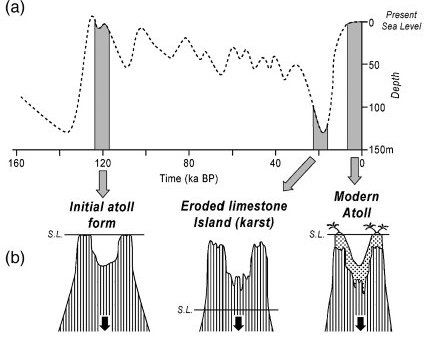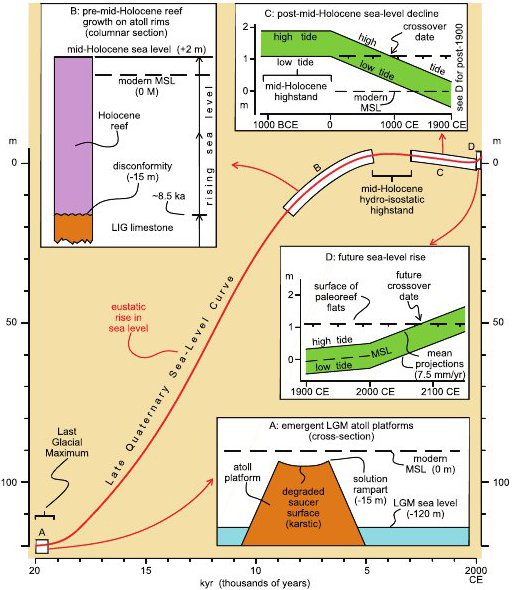Coral atolls and rising sea levels: That sinking feeling
Posted on 20 May 2011 by Rob Painting
People living on coral atolls have long been the 'poster child' of global warming, and the threat posed by rising sea levels. Some emotive reporting in the media (and rightly so) tend to give the impression that the atolls should have been under water by now. Clearly this isn't the case, as Webb & Kench (2010) show, the sea level rises experienced in the South Pacific so far (2mm per year) have had little effect on the loss of land area on the atolls. Despite some people being confused regarding the timescale involved, the threat is still very real.
The ocean is, in fact, littered with thousands of former coral reefs and atolls which 'drowned' when they failed to grow fast enough to match sea level. Being generally less than 3 metres above sea level, coral atolls are particularly vulnerable to rising seas. People living on coral atolls in the Pacific will be displaced from their homelands in the coming decades once sea level rises above the solid reef foundations which formed during a temporary regional sea level highstand 4,000 to 2,000 years ago. When this happens, the formerly stable atolls will be subject to erosion by waves, long before the atolls are completely submerged.
Coral atoll formation
Coral reefs occupy tropical and sub-tropical waters and accumulate as generations of coral build upon the "bones of their ancestors". Given the right conditions coral are able grow fast enough to keep pace with moderate rates of sea level rise. So what appears to be solid rock formed by the Earth's geological processes, is in fact the result of biological activity over many years.

Figure 1 - coral formation on the uplifted atoll of Niue. Photo courtesy of Wikimedia Commons.
In the mid-19th century, after voyaging throughout the Pacific, Charles Darwin demonstrated remarkable insight by putting forth the idea that coral atolls are the remnants of submerged ocean volcanoes (Darwin 1842). He envisioned that, as volcanic activity ceased and the volcano slowly submerged beneath the sea, coral were able to grow on it's shores, keeping pace with the subsidence rate and therefore able to maintain a presence at sea level. At the time however, Darwin was unaware of the huge changes in sea level which accompanied the Earths transition in and out of the Quaternary ice ages, so the process is more complex than he realized.
We now know that as the planet cooled at the onset of each ice age, more and more of the Earth's water became locked up in the growing ice sheets. At the last glacial maximum, sea level fell over 120 metres lower than modern sea level. This left coral high and dry and their remains were exposed to chemical weathering by carbonic acid in a process known as karstification. It is this weathering process which is responsible for the bowl-like shape which many coral reefs take on (Purdy & Winterer 2001).
Core samples drilled deep from coral atolls (Royal Society of London 1904, Ladd & Ingerson 1953) show that Darwin was correct. Atolls consist of old coral reef (limestone) sitting on top of a volcanic rock base. Often the reef limestone is hundreds of metres thick, consisting of layers of reef growth that have built up over many millions of years. During the ice age cycles the atoll tops have been repeatedly submerged and exposed as sea level fluctuated up and down (Purdy 1974). While exposed to the air the atoll tops have been eroded down, and when sea level rose again during the interglacials, new coral reef has reclaimed the atoll summit. The top 10 -15 metres of many atolls represent the "recent" growth during the current interglacial, the Holocene. So rather than a continual process, as Darwin originally proposed, coral atoll formation has been a rather stop-start affair.

Figure 2 - Schematic of atoll history through ice age sea level fluctuation. a) sea level thousands of years before & up to present. b) Atoll form relative to sea level. From Woodroffe 2007
The Darwin Point & Guyots
A Darwin Point defines the threshold at which a coral reef "drowns". It refers to a point where changing environmental conditions means the reef cannot grow fast enough to keep in touch with the sea surface, and therefore receive enough sunlight to grow (Grigg 1982). It therefore effectively drowns and dies. Guyots are flat-topped seamounts deep below the sea surface. Thousands of guyots are spread throughout the Pacific. These were once coral atolls, but "drowned" when they passed the Darwin Point.
Because coral reefs flourish in a narrow range of environmental conditions, coral growth can slow down when waters become too hot, too cool or too acidified (Flood 2001), (Scheibner & Speijer 2008). The Emperor seamounts in the Hawaiian Island chain are a case in point. These volcanic islands sit on a continental plate which has gradually drifted northwest into cooler waters over the timespan of tens of millions of years. As the northernmost atolls passed the Darwin Point they "drowned". This occurred in a sequential fashion as each atoll passed the threshold. Kure atoll, is the next in the chain destined for submersion, as it's coral reef growth has almost dropped to zero (Grigg 2008)
Holocene Reef Growth
Coral reef growth during the Holocene, like that of ancient reefs, also has a complicated history. Many reefs around the world show evidence of back-stepping, a point where the reef is unable to keep up with sea level and drowns, but new coral is able to re-establish in shallower water closer to shore. Many regions also harbour relict reefs which have drowned during the Holocene. One vast relict complex exists in deeper water off the Great Barrier Reef. All of which is suggestive of rapid jumps in sea level rise, probably from the collapse of the large glacial lakes on the gigantic Northern Hemisphere ice sheets as they disintegrated (Blanchon & Shaw 1995). The full picture, yet to be fully resolved, may be more convoluted.
Pacific sea level highstand in the Holocene
At around 8-9 thousands years ago sea level caught up with the tops of the eroded atolls and new Holocene reef growth began to be cemented over the older reef foundations. Sea level reached a highstand in the Pacific between 4-2000 years ago , Pirazzoli 1987, Dickinson 2003, Woodroffe & McLean 1998). There is also evidence of a highstand in the Indian Ocean at the Maldives (Kench 2009). Coral reef tops grew to this higher sea level but were exposed once local sea level fell again, through ocean siphoning (Mitrovica & Milne 2002).

Figure 3 - Pacific atoll formation during the Holocene. a) Old atoll form relative to sea level approx 20,000 years before present. b) Sea level rises above old reef and new growth begins reaching point above modern day sea level. c) Sea level declines, leaving reef flat exposed above sea level. d) Sea level begins rising. Reef flat will be over-topped mid to late 21st century
This process meant that, unlike sand cays where debris and sediment is constantly shifting (Flood 1986, Flood & Heatwole 1986) coral atolls had solid foundations above sea level upon which organic matter could accumulate. Excluding major storms these foundations made the atolls resistant to wave damage, and therefore stable over the last few thousand years.
Dating of human artifacts at archeaological sites shows Pacific atolls have not been inhabited for more than 1000 to 1500 years Dickinson 2009, which is consistent with the history of Holocene atoll formation.
The end of atoll nations
Now that global sea level is rising once more, the solid foundations (reef flats) which underpin the stable Pacific atolls will be overtopped by the sea at some point. Many of these are 0.5 to 1 metre above local high tide. Submerging these solid foundations will lead to the atolls being vulnerable to wave damage. Erosion will begin to sweep away the rubble, sediment, and thin soils, making them uninhabitable at some point in the future. Dickinson 2009 has constructed a table of estimated crossover dates for Pacific atolls. These are dates, based on projected rates of sea level rise, where the solid reef foundations are over-topped. Generally these cross-over dates occur mid 21st century at the earliest.
Homeless
As we've seen, coral reefs aren't always capable of keeping pace with sea level rise. To do so they need environmental conditions to be within their 'goldilocks zone'; move outside that and they are liable to drown. It just so happens that global warming is in the throes of doing that very thing. Ocean acidification and coral bleaching will severely curtail or even stop reef growth completely (Silvermann 2009).
But more significantly, a regional sea level highstand thousands of years ago formed the stable foundations upon which the soils and vegetation developed. Even if the atoll coral reefs were able to keep pace with future sea level rise, it won't stop the sea rising above the old reef flats and exposing the atolls to persistent wave attack.
So, although coral atolls may grow as sea level rises, this hasn't always been the case in the past, and won't be the case in the future. Atoll islanders may be hanging in there right now, but eventually global warming, and the rising seas, will make them homeless.
NOTE: Rob has written Basic, Intermediate, and Advanced rebuttals to the myth "Coral atolls grow as sea levels rise"































 Arguments
Arguments






























[dana1981] It's SkS standard practice to publish a blog post to advertise when a new rebuttal is completed. That's what this is.
[dana1981] Yes
[dana1981] Survival of the fittest. He was just really, really fit!
Actually it should say 1842. Change made, thanks.